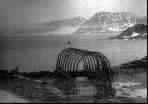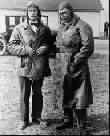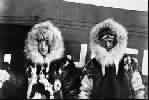|
|
|
 |
 |
 |
| 1897 Andrée Balloon Flight from Danes Island (Danskøya), Spitsbergen. |
| Rather than a fool-hearty scheme, Swedish engineer Salomon A. Andrée formulated elaborate plans for flying from Spitsbergen to the North Pole in a hydrogen-filled balloon. His base on Danes Island even contained a generating plant for producing hydrogen. Bad weather prevented a planned departure during the summer of 1896. Returning the following summer, Andrée and his two companions, Nils Stridberg and Knut Frankl, departed Danes Island on July 11, 1897 and disappeared somewhere over the polar ice pack. Thirty-three years later, a 1930 scientific expedition discovered their remains on remote White Island (Kvitøya). Diaries and journals found on White Island told of their crash on the ice, the trek across the polar ice pack and eventual return to land on White Island. |
| Polar First: First attempt to reach the North Pole by air. |
| First-hand account: Andrée, S. A., The Andrée Diaries, contains an account of the flight taken from diaries and journals found on White Island. |
| Photo: The Andrée Museum. |
|
| 1907 First Wellman airship attempt to reach the North Pole from Danes Island. |
| 1909 Second Wellman airship flight from Danes Island. |
| In 1906, American journalist Walter Wellman established a base, Camp Wellman, on Danes Island at the site of Andrée's 1896-97 base for a planned dirigible (steerable airship) flight to the North Pole. Shortly into its first attempt in 1907, Wellman's airship the America encountered a snowstorm and landed on a nearby glacier. On his second attempt in 1909, Wellman and his crew encountered mechanical problems roughly 30 miles out over the polar ice pack and returned to land. Wellman remains something of an enigma in the annals of polar exploration. It continues to be a subject of debate as to whether Wellman's flights, as well as an earlier overland trek from Franz Josef Land, were serious attempts to reach the pole or more in the nature of publicity stunts. Nevertheless, Wellman's flights and the accompanying publicity they produced gave impetus to the concept of aerial exploration of the polar regions. |
| Polar First: First attempt to reach the pole by airship. |
| First-hand account: Wellman, W., Aerial Age, contains accounts of the 1907 and 1909 Danes Island flights. |
| Photo: from Wellman's book, Aerial Age. |
| |
| 1923 Amundsen-Omdal airplane flight from Wainwright (near Pt. Barrow), Alaska. |
| The great Norwegian explorer Roald Amundsen--who achieved world-renown as the leader of the first expedition to reach the South Pole and the first to sail the fabled Northwest Passage--learned to fly in 1914. Amundsen`s 1923 Maud expedition to the polar sea carried two small planes for observation purposes but both planes were damaged and rendered unusable. Meanwhile that same year (1923), Amundsen, with his Norwegian pilot Oscar Omdal, planned to fly the polar rim from from a base in Wainwright (near Pt. Barrow), Alaska to Spitsbergen. However, the undercarriage of the German-made Junkers airplane was damaged beyond repair in a test flight and plans for the flight had to be abandoned. Nevertheless, although these flights were unsuccessful, Amundsen must be credited with pioneering the use of aircraft in polar exploration. Five years later, in 1928, Wilkins and Eielson realized Amundsen`s vision of flying the polar rim by airplane (see Part 2), but by this time Amundsen had already flown from Spitsbergen to 88ºN (1925) and crossed the polar sea by way of the North Pole in the airship Norge (1926). |
| Polar First: First attempt to fly the polar rim, Alaska to Spitsbergen, by airplane. |
| First-hand account: Amundsen, R., My Life as an Explorer, Amundsen's autobiography written shortly before his death in 1928, contains an account of the Alaska flights. |
| Photo: Library of Congress. |
| Spitsbergen support of Amundsen-Omdal flight. |
| The Junkers factory in Germany, manufacturers of the aircraft Amundsen intended to fly from Alaska, planned to send a Junkers seaplane to Spitsbergen in case a rescue operation became necessary. When Amundsen's plans were abandoned the Junkers contingent continued on to Spitsbergen for an extensive aerial reconnaissance |
| Polar First: First aerial photography and mapping of Spitsbergen. |
| First-hand account: Mittelholzer, W., et al., By Airplane towards the North Pole, contains some spectacular aerial photographs of Spitsbergen. |
| |
| 1925 Amundsen-Ellsworth North Pole airplane flight from Kings Bay (Kongsfjorden), Spitsbergen. |
| In 1925, Amundsen teamed with American adventurer Lincoln Ellsworth for another attempt at polar flying. This time plans called for flying two Dornier Wal [whale] flying boats to the North Pole. The two flying boats, designated N-24 and N-25, landed on the ice at approximately 88ºN (87º 44' to be precise) and were on the ice for three weeks before Amundsen, Ellsworth, and four crewmembers could return in one plane to Spitsbergen. While on the ice they made numerous scientific observations (weather, pressure, ice conditions, etc.) including soundings that established that there was no land beyond Spitsbergen on the European side of the pole. |
| Polar First: First attempt to reach the North Pole by airplane; first landing on the ice near the pole. At approximately 88ºN, they were little more than 120 nm from the pole; since neither Cook's nor Peary's north pole claims could be confirmed, this may have been a record Farthest North as well. |
| First-hand account: Amundsen, R. and Ellsworth, L., Our Polar Flight, 1925, is the best source of information on the flight. |
| Photo: from the book, Our Polar Flight. |
| |
| 1926 Byrd airplane flight from Kings Bay and claimed attainment of North Pole. |
| Byrd, with pilot Floyd Bennett in the Fokker tri-motor Josephine Ford [named for the daughter of Edsel Ford who contributed $10,000 to the Byrd expedition], claimed to have reached the North Pole on May 9, 1926. Byrd with Bennett at the controls took off from Kings Bay shortly after midnight on May 9 and returned a scant 15½ hours later. In order to have completed the 1500 plus mile trip in 15½ hours, the Josephine Ford would have to have maintained an average groundspeed in excess of 100 mph, a speed beyond the aircraft's capabilities. Byrd's claim of a helpful tailwind both ways was not supported by weather reports from around the polar rim. Most history books and encyclopedias continue to credit Byrd with being the first to fly to the North Pole. However, particularly among aviators, Byrd`s account of the flight was in serious doubt from the very beginning and many historians now discredit the claim. |
| Polar First: Despite the fact that this is probably the best-known of the polar aviation firsts, even if Byrd had reached the pole as he claimed, the flight would have been of little value other than for publicity purposes. Amundsen and Ellsworth had flown the same route and landed on the ice at approximately 88ºN the previous year; airborne at nearly 88ºN, they could see almost to the pole and while on the ice they made numerous scientific observations. |
| First-hand account: Byrd, R., Skyward, 1926, (ghostwritten by Fitzhugh Green), contains a rather fanciful account of Byrd`s north pole flight. |
| Photo: Library of Congress |
 |









